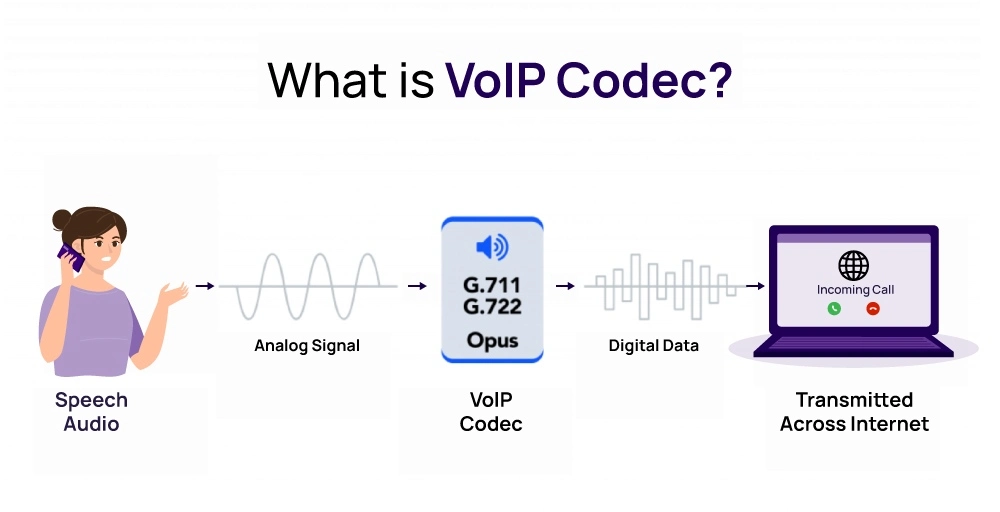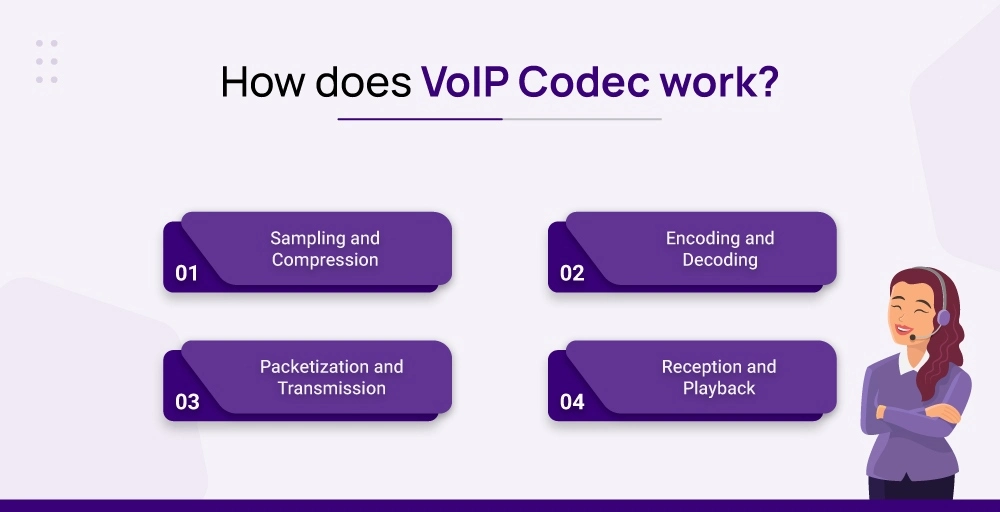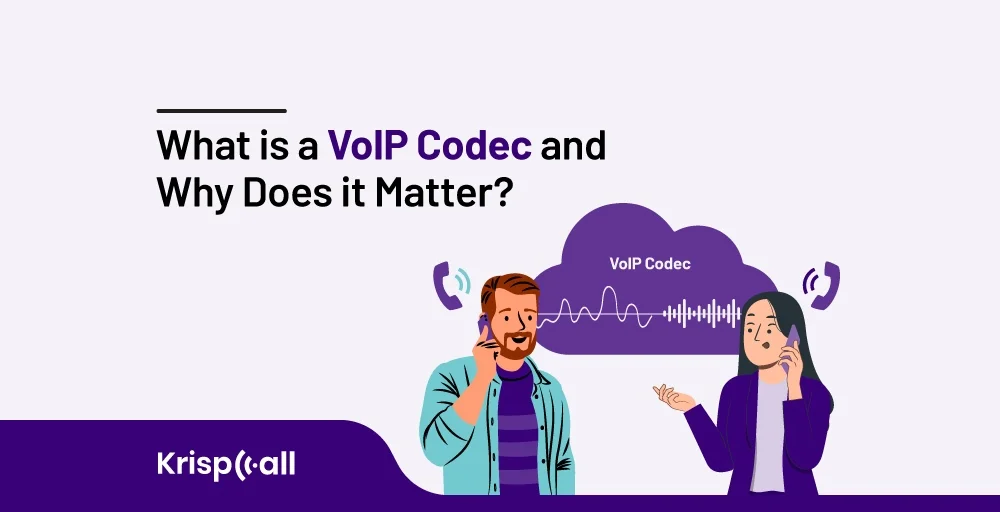Apparently, over the last couple of decades, Voice over Internet protocol services have revolutionized how we connect with each other.
But what lies at the heart of this transformation is VoIP Codecs, which play a pivotal role in determining and shaping the quality of calls carried out through these services.
So basically have you ever wondered what these codecs are? Or in what ways do they affect the quality of calls?
Well, then, this is what this article is about. We’ll discuss VoIP and audio quality a bit, as well as give a brief overview of VoIP Codec organization.
🔑 KEY HIGHLIGHTS
- VoIP Codec is a technology that compresses and decompresses audio data to facilitate voice communication over the Internet.
- VoIP Codec not only impacts the quality of calls but also the bandwidth usage and latency.
- G.722 is preferred for high audio quality and bandwidth, G.729 for bandwidth efficiency, G.711 for good voice quality with ample bandwidth.
What is VoIP Codec?

A VoIP codec (Voice over Internet Protocol codec) is a software or hardware component that encodes and decodes audio signals for transmission over an IP network.
To put it simply, it is a technology that compresses and decompresses audio data to facilitate voice communication over the Internet.
The main purpose of these algorithms is to reduce the size of audio files or streams so that they can be transmitted efficiently over the Internet. Codecs can either be hardware-based or software-based.
For VoIP communications, there are various codecs, each with its own compression algorithms and characteristics. These codecs differ in terms of audio quality, bandwidth requirements, computational complexity, and other factors. Among the most commonly used VoIP codecs are G.711, G.729, Opus, and others.
Understanding the fundamentals of audio quality
For today’s company, a reliable VoIP system has become more essential where fidelity is the foundation of successful business communication – this is why phone audio quality is so important.
To understand audio processing more deeply, it is important to understand the common terms related to sound quality.
- Bitrate: An amount of data that is transferred into audio, whereas audio bitrates mean it captures more sound information per second. Typically, an increase in bitrate implies an improvement in sound quality and vice-versa. For instance, you can think of CD vs MP3 quality.
- Sample rate: it is an audio sample that is taken every second. Basically, every single sample will tell you the signal waveform’s total amplitude value over a specific period. For instance, you can think of a phone call vs high-fidelity recording.
- Frequency response: It is a range of frequencies that the audio equipment can accurately reproduce. The impact on quality depends on a wider frequency response that captures a broader spectrum of sound, making it more natural and realistic. For instance, you can think of AM radio vs full-range speakers.
- Dynamic Range: This refers to the range of sounds an audio system can deliver without distortion. A wider dynamic range preserves small details precisely, especially in complex music or recordings with quiet and loud passages.
- Signal-to-Noise Ratio (SNR): The ratio of the desired audio signal to unwanted background noise is the Signal-to-Noise Ratio. If the SNR is higher, then you can get cleaner and clearer audio results with less hum or other disruptions.
- Distortion: Any unwanted alteration or interference with the original audio signal is a distortion. It can introduce harshness, artifacts, and loss of detail, making the audio sound unpleasant and unnatural.
Why does VoIP Codec matter?
VoIP Codec plays a vital role in communication interaction, where it does not only impact the quality of calls but also the bandwidth usage and latency.
Also, the main purpose of the codec in VoIP is to convert your analog voice signals into digital data packets and vice versa. This compressed data can be efficiently transmitted over the internet, which helps you facilitate real-time voice communications.
Additionally, codecs basically act as translators, which helps to optimize data size for effective transmission while maintaining acceptable audio quality for your specific needs.
Lastly, understanding codecs allows you to optimize the VoIP call quality based on your network limitations and priorities. Also, try to minimize bandwidth usage without sacrificing too much audio clarity. As well as, if you want to play video games or make conference calls, you can choose the appropriate codec.
How does VoIP Codec work?

1. Sampling and Compression
The VoIP codec converts the analog voice signal into a digital format by sampling it at regular intervals. So for efficient network transmission, the digital signal is compressed to reduce its size. Moreover, the compression algorithms vary between codecs and can affect factors like audio quality and bandwidth usage.
2. Encoding and Decoding
Once the voice signal is compressed, it’s encoded into a format suitable for transmission over the network.
This encoding process involves converting the digital signal into a stream of data packets, often using techniques like Pulse Code Modulation (PCM) or other digital signal processing methods.
On the receiving end, the encoded data packets are decoded back into a digital signal and then decompressed to reconstruct the original voice signal.
3. Packetization and Transmission
The encoded and compressed voice data is packetized, meaning it’s divided into smaller data packets for transmission over the network.
Each packet typically contains a portion of the voice data along with additional information for routing and error correction.
These packets are then transmitted over the network using protocols like User Datagram Protocol (UDP) or Transmission Control Protocol (TCP).
4. Reception and Playback
At the receiving end, the transmitted packets are received and reassembled into the original voice signal. The packets may arrive out of order or be subject to packet loss or jitter due to network conditions.
VoIP codecs often incorporate techniques like packet reordering, error concealment, and jitter buffering to mitigate these issues and ensure smooth playback of the voice signal.
Once the packets are received, decoded, and decompressed, the reconstructed voice signal is played back through the user’s device, such as a phone or computer speaker.
So these are the overview of how VoIP codec works.
How VoIP Codecs Improve Call Quality?
Rather than directly enhancing audio quality, VoIP codecs manage the trade-off between audio quality and other factors like latency and bandwidth.
By removing redundant or less perceptible information from the audio signal, codecs can significantly reduce the amount of data required for transmission, thus conserving bandwidth without compromising audio quality.
Moreover, modern VoIP codecs often employ adaptive bitrate control and dynamic packet size adjustment algorithms. Through it, they can adapt to changing network conditions in real time. Due to this adaptability, it is capable of providing optimal performance even under different bandwidth limitations. This further enhances the quality and reliability of calls.
Overall, VoIP codecs compress the audio data to improve call quality by efficiently mitigating the effects of network transmission issues and adapting to changing network conditions. Finally, implementing advanced audio processing techniques to enhance audio fidelity and clarity.
What are the types of VoIP Codecs?
Since there are various VoIP codecs, here are some of the best codecs for VoIP that can provide more audio quality according to your needs and requirements.
1) G.711
This codec was introduced by the International Telecommunication Union (ITU) back in 1972 for telephony use. It comes in two variants, which include G.711u (μ-law), which is used in North America, and G.711a (A-law) in Europe, respectively.
This codec offers high-quality audio comparable to traditional phone calls, also known as “toll-quality.” However, it comes with a high bitrate of 64 kbit/s, which can be demanding for limited bandwidth situations
2) G.722
G722 is another high-quality codec, which provides a slightly lower bitrate than G.711 (around 64 kbit/s) while maintaining good audio fidelity. In other words, it has a wideband and is likely to use more complex encoding, making it computationally demanding.
3) G.722.2 (AMR-WB)
This codec is also known as Adaptive Multi-Rate Wideband. This wideband audio quality means that it captures a wider range of frequencies for a more natural sound. It has a moderate bitrate ranging from 12-24 kbit/s and offers superior audio quality compared to narrowband codecs like G.711 and G.729. It’s commonly used in high-quality voice communications over IP networks.
4) G.729
If you’re looking for a codec that has a low bandwidth requirement but still produces an acceptable audio quality, then G.729 is the way to go. It operates at 8 kbit/s, making it efficient for resource-constrained environments like mobile networks. While the audio quality is lower compared to G.711/G.722, it remains good for voice calls.
5) Opus
Last but not least, we have OPUS. This codec is newer, highly versatile, and has an ultra-wideband codec, which delivers high audio quality as well as low latency for a wide variety of bitrates. This technology can be used for a variety of VoIP applications, including real-time internet communication.
Additionally, Opus is an open-source codec that does not require any licensing fees for usage.
Have a look at the VoIP codec comparison
| Codec | Sample rate (samples per second) | Latency | Bitrate | Frequency Signal | Best For |
| G.711 | 8000 samples per second | 125 µs | 64 Kbps | 300-3400 Hz, narrowband | Communication between VoIP and PSTN |
| G.722 | 50-7000 H, wideband | 4 ms | 32 Kbps | 50-7000 H, wideband | A low latency voice with good quality |
| G.722.2 | 50-7000 Hz, wideband | 25 ms | 48-64 Kbps | 50-7000 Hz, wideband | Voice quality and bandwidth flexibility are compromised |
| G.729 | 300-3400 Hz, narrowband | 15 ms | 8 Kbps | 300-3400 Hz, narrowband | Bandwidth usage is low |
| Opus | 50-20,000 Hz, ultra-wideband | 26.5 ms | 6-510 Kbps | 50-20,000 Hz, ultra-wideband | HD voice and clear sound |
What is the Impact of codec selection on call quality?
Your codec selection plays a major role in determining your call quality, such as balancing fidelity and accuracy.
This codec helps to regulate how efficiently the audio signal is compressed and transmitted over the network affecting factors such as clarity, latency, and so on.
Additionally, the codec’s ability to handle network conditions like packet loss and jitter influences call stability and reliability.
Therefore, choosing the right codec for VoIP communications is crucial to maintaining an optimal balance between bandwidth efficiency and call quality.
Which is the Best VoIP Codec?
There are several voice codecs available, but you need to find the VoIP codec that works best for you according to your requirements as well. Ok, let’s compare them.
G.711 vs G.722 VoIP Codecs
G.711 offers a standard audio quality with a narrowband frequency range, whereas G.722 provides higher audio quality with a wideband frequency range, resulting in clearer voice communication. G.711 uses more bandwidth than G.722 due to its lower compression ratio.
G.729 vs G.711 VoIP Codecs
G.729 offers low bandwidth in comparison to G.711 due to its uncompressed nature. However, you may only get decent voice quality. Also, G.729 can be used in situations where bandwidth is limited, such as low-speed connections or congested networks.
However, regarding compatibility, G.729 is supported by many VoIP systems and devices, but it may require additional licensing fees because of its proprietary nature; in contrast to G.711, it is widely supported.
🎁Bonus: Tips to Choose the Right VoIP Codec Solution

Here we have got some factors to consider and tips to choose the right VoIP Codec:
- Bandwidth: High-speed internet connections allow the use of higher bitrate codecs such as G.711 for crystal-clear audio. Also, you can opt for lower bitrate codecs like G.729 or Opus to avoid call disruptions. Furthermore, if you expect heavy usage, take into account the number of ongoing calls and prioritize efficiency.
- Device compatibility: Ensure your VoIP phones and software support the desired codec. Whereas using the wrong codec can lead to call quality issues. So check manufacturer specifications and consult with your VoIP provider if unsure.
- Voice Quality: To balance fidelity with bandwidth, you should prioritize clarity by choosing G.711 for more audio-quality calls if bandwidth allows. Also, you can consider using G.729 or Opus for smooth calls on limited bandwidth. For instance, if you have important meetings, then use higher fidelity codecs and lower bitrates for casual calls.
- Latency: Low latency is crucial for natural conversations. So consider network stability because unstable connections can increase latency regardless of the codec. Hence, for real-time responsiveness, choose codecs with lower bitrates that have lower latency.
Final Thoughts
As a final note, VoIP codecs are essential for making calls sound clear and natural and are undeniable heroes of clear and effective communication these virtual telephone days.
Meanwhile, choosing among G.711, G.722, and G.729 depends on various factors, such as desired audio quality, bandwidth availability, network conditions, and compatibility with existing infrastructure.
Overall, G.711 remains a popular choice for VoIP applications, while G.722 and G.729 offer improvements in audio quality and bandwidth efficiency respectively, which may vary based on network conditions and deployment needs.
Lastly, by choosing cloud telephony like KrispCall, you can enhance the quality of your VoIP calls and take advantage of its versatility.
FAQ
Does bitrate affect audio quality?
Yes, bitrate does affect audio quality. When it comes to digital audio, bitrate refers to the amount of data used to represent a certain duration of audio. Generally, higher bitrates result in better audio quality because there is more data available to represent the audio waveform accurately.
Which voice codec is most common?
The most common voice codec used in VoIP (Voice over Internet Protocol) is the G.711 codec. It is widely used for its simplicity and compatibility across various devices and platforms.
What is the best VoIP codec for high latency?
For high-latency environments, the best VoIP codec may vary depending on specific requirements. However, codecs designed to be resilient to packet loss and delay, such as Opus or G.729, are often preferred in such situations.
How fast is the G711 codec?
The G.711 codec operates at a speed of 64 kbps (kilobits per second) for each direction (sending and receiving), resulting in a total bitrate of 64 kbps. When it comes to sampling rate, it uses 8 kHz, which means that it samples the audio signal 8000 per second, allowing it to capture and transmit voice signals accurately.
What is the bitrate of G711?
The bitrate of the G.711 codec is 64 kbps.





